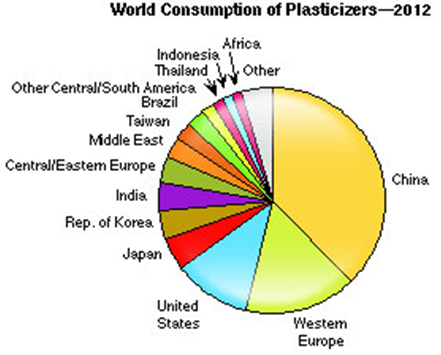
|
Plasticizers render brittle materials soft, flexible or ductile and find application in plastic and rubber products, paints, varnishes, adhesives, etc. Ceresana forecasts global market value of plasticizers to increase to more than US$19.5 bln in 2020 driven by major growth markets Asia-Pacific and Eastern Europe. The by far most important application area for plasticizers is plastics products made from PVC in particular. In 2012, about 87% of global plasticizers consumption was processed in plastic products, the majority being films and cables. Demand for plasticizers in the production of rubber products, paints and varnishes as well as adhesives, is considerably lower. The highest growth rates is expect to continue for the BRIC countries (Brazil, Russia, India, China), but USA is also likely to increase demand for plasticizers during the next eight years after losses incurred in the past. Demand in Western Europe is anticipated to hardly exceed stagnation; however, an increasing demand for phthalate-free plasticizers will stimulate the market. Health concerns of consumers and possible further bans on the use of phthalates lead to an increased demand for phthalate-free and biobased plasticizers. Ceresana expects phthalate plasticizers, especially DEHP, to lose even higher market shares at the favor of phthalate-free products than they did in the past. Most of the new production capacities created in Western Europe are exclusively dedicated to the production of phthalate-free plasticizers. Even China is exhibiting excess capacities for DEHP by now. So far, DEHP accounted for about 60% of the Asian-Pacific market. As per IHS Chemicals, plasticizers are organic esters added to polymers to facilitate processing and to increase the flexibility and toughness of the final product by internal modification of the polymer molecule. Flexible polyvinyl chloride (PVC) accounts for 80-90% of world plasticizer consumption. Plasticizers are grouped into the following categories: phthalates, aliphatics (mainly adipates and hydrogenated phthalates), epoxy, terephthalates, trimellitates, polymerics, phosphates and others. Phthalic acid esters, generally known as phthalate plasticizers, are by far the predominant type of plasticizer produced and consumed in the world. Phthalates accounted for just over 78% of the world consumption of plasticizers in 2012, down from approximately 88% in 2005; they are forecast to account for 75.5% of world consumption in 2018. China is the single-largest plasticizer market in the world, accounting for nearly 38% of world consumption in 2012; it also has the highest forecast consumption growth rate during 2011-2018, spurred by increased plasticizer consumption in goods for both domestic and export markets. Other Asian countries taken together, and including Japan, constitute the second-largest plasticizer consuming region, with nearly 21% in 2012, followed by Western Europe (16.0%) and North America (about 13%). Demand for plasticizers in North America is expected to grow at a moderate rate (2.2% per year) during 2011-2018. European demand growth is forecast at an average annual rate of 1.2% during 2011-2018; Western European demand will grow at about 1% while markets in Central and Eastern Europe are expected to grow at a higher rate of 1.9% annually.
|
 |
Demand for most downstream plasticizer markets is greatly influenced by general economic conditions. As a result, demand for plasticizers largely follows the patterns of the leading world economies. The major end-use markets include construction/remodeling, automotive production and original equipment manufacturers (OEM). Communication and building wire and cable, film and sheet (calendered and extruded), coated fabrics and dispersions (flooring and other) are the largest markets for plasticizers. World consumption of phthalate plasticizers is forecast to grow at an average annual rate of 2.4% during 2011-2018. World consumption of lower-molecular-weight phthalates is forecast to decline in many regions as a result of replacement, mostly by nonphthalates. World consumption of other plasticizers (terephthalates, aliphatics, trimellitates, epoxy, polymerics, benzoates and phosphates) is forecast to grow at an average annual rate of 5.7% during 2011-2018. Terephthalates, benzoates and some aliphatics (mainly hydrogenated phthalates) are forecast to grow at rapid rates as they replace phthalates. Other aliphatic plasticizers, such as citrates and alkane sulfonic esters of phenol, are also expected to grow significantly during 2011-2018, albeit from smaller bases. |
Previous Article
Next Article
{{comment.DateTimeStampDisplay}}
{{comment.Comments}}